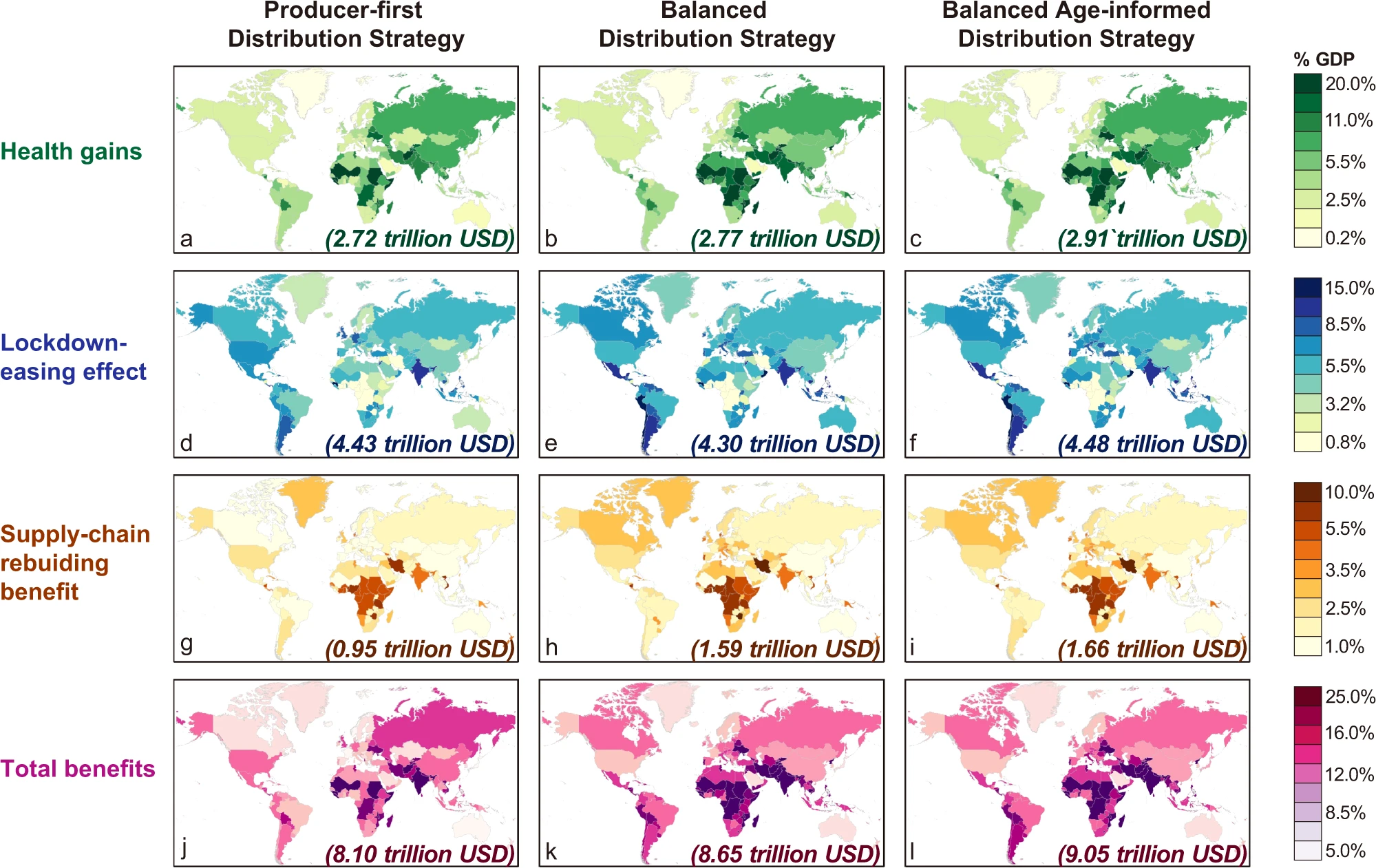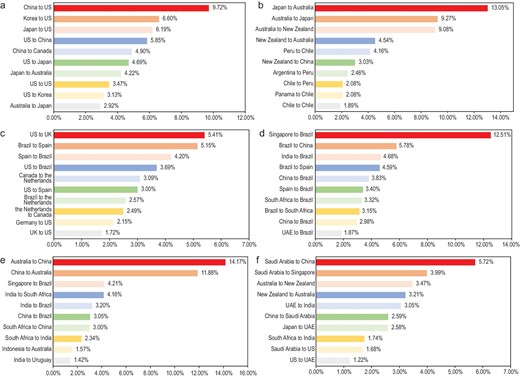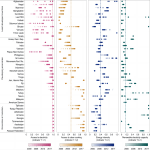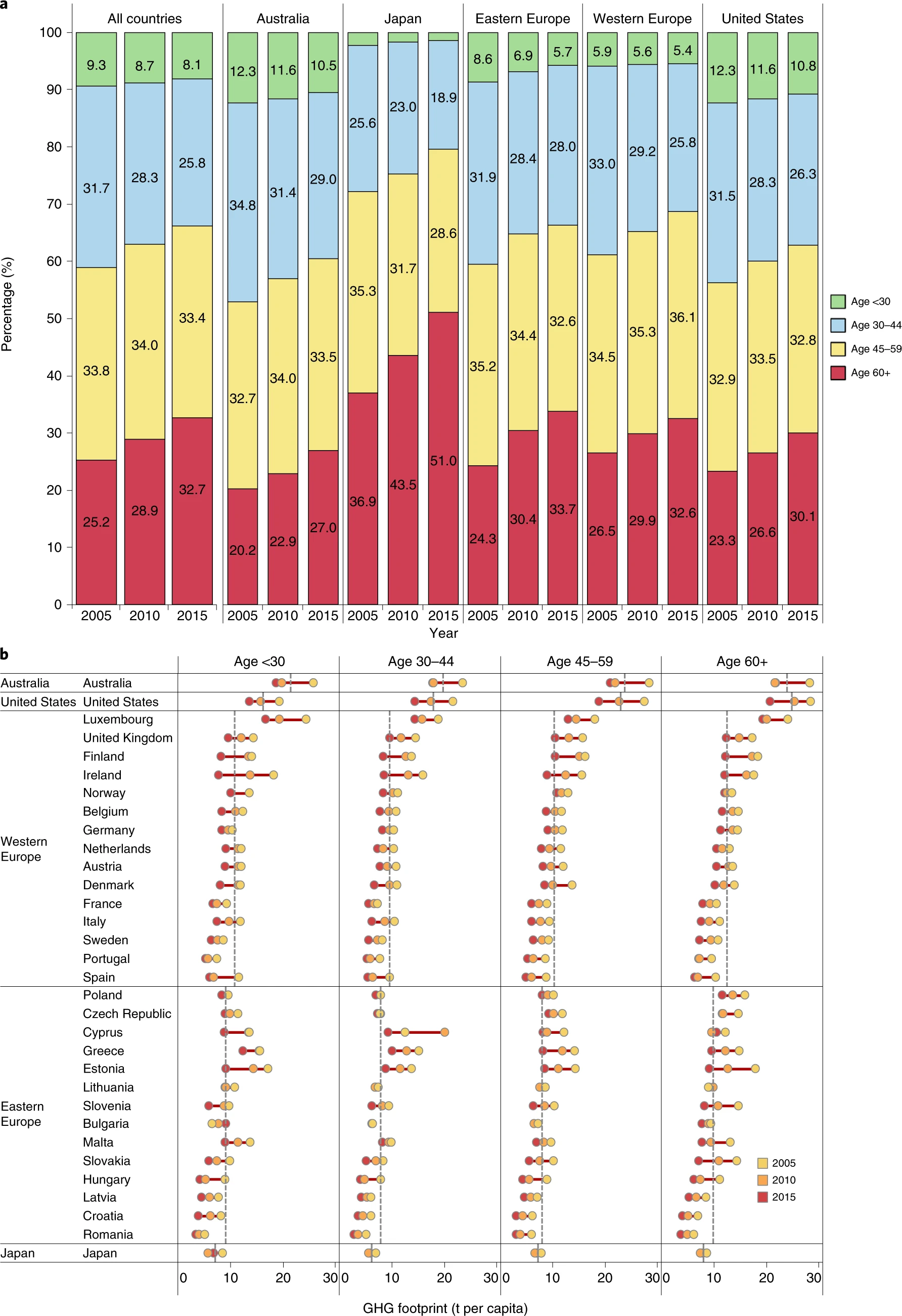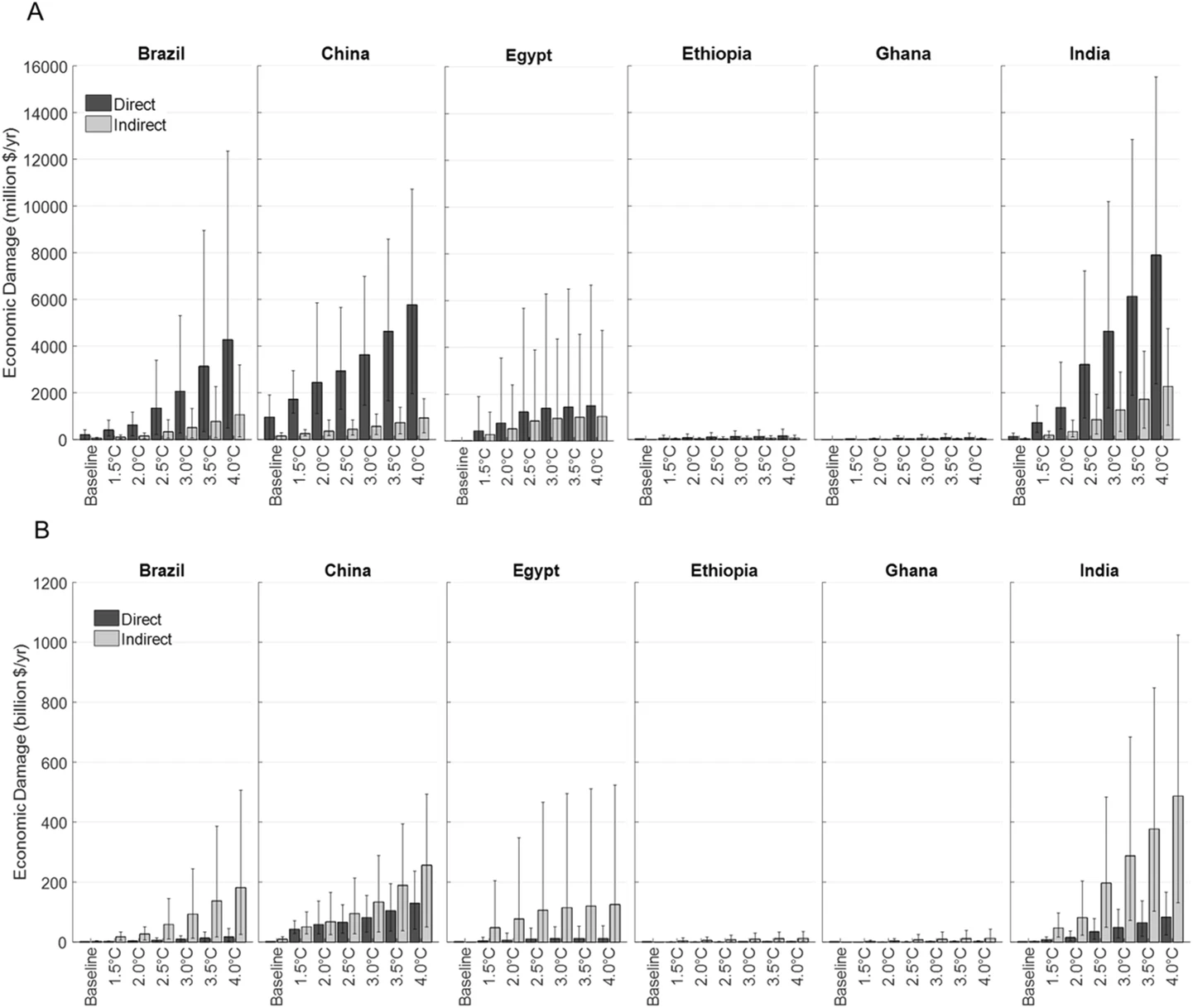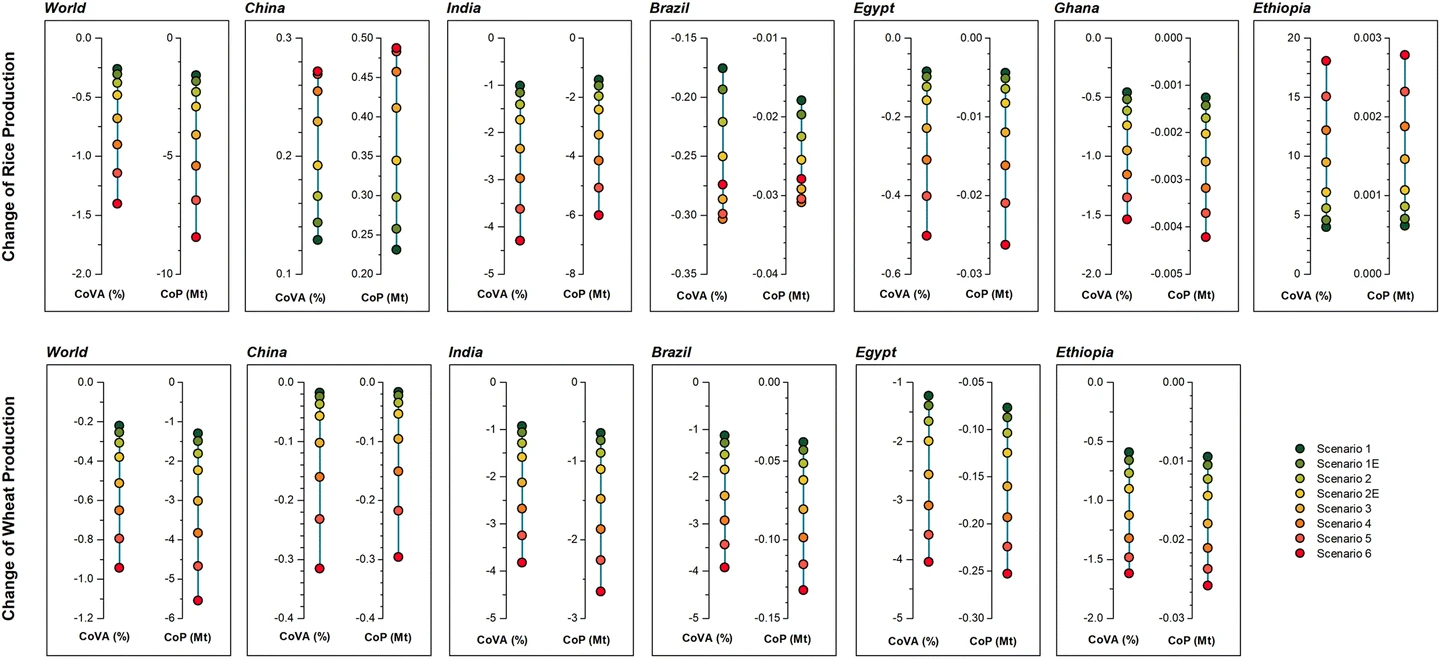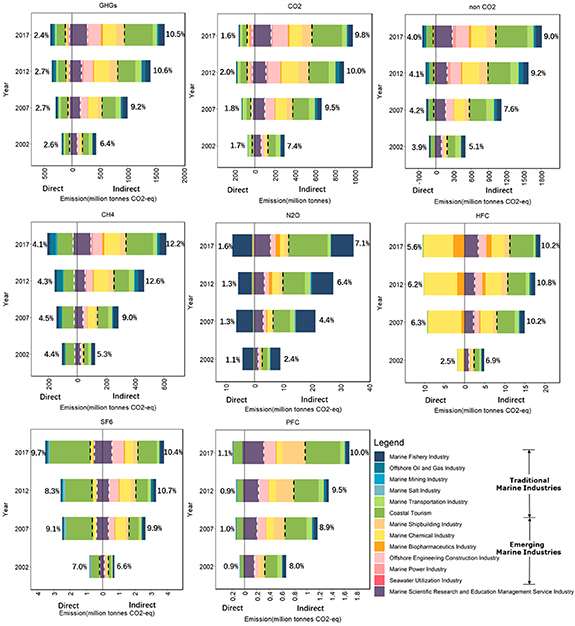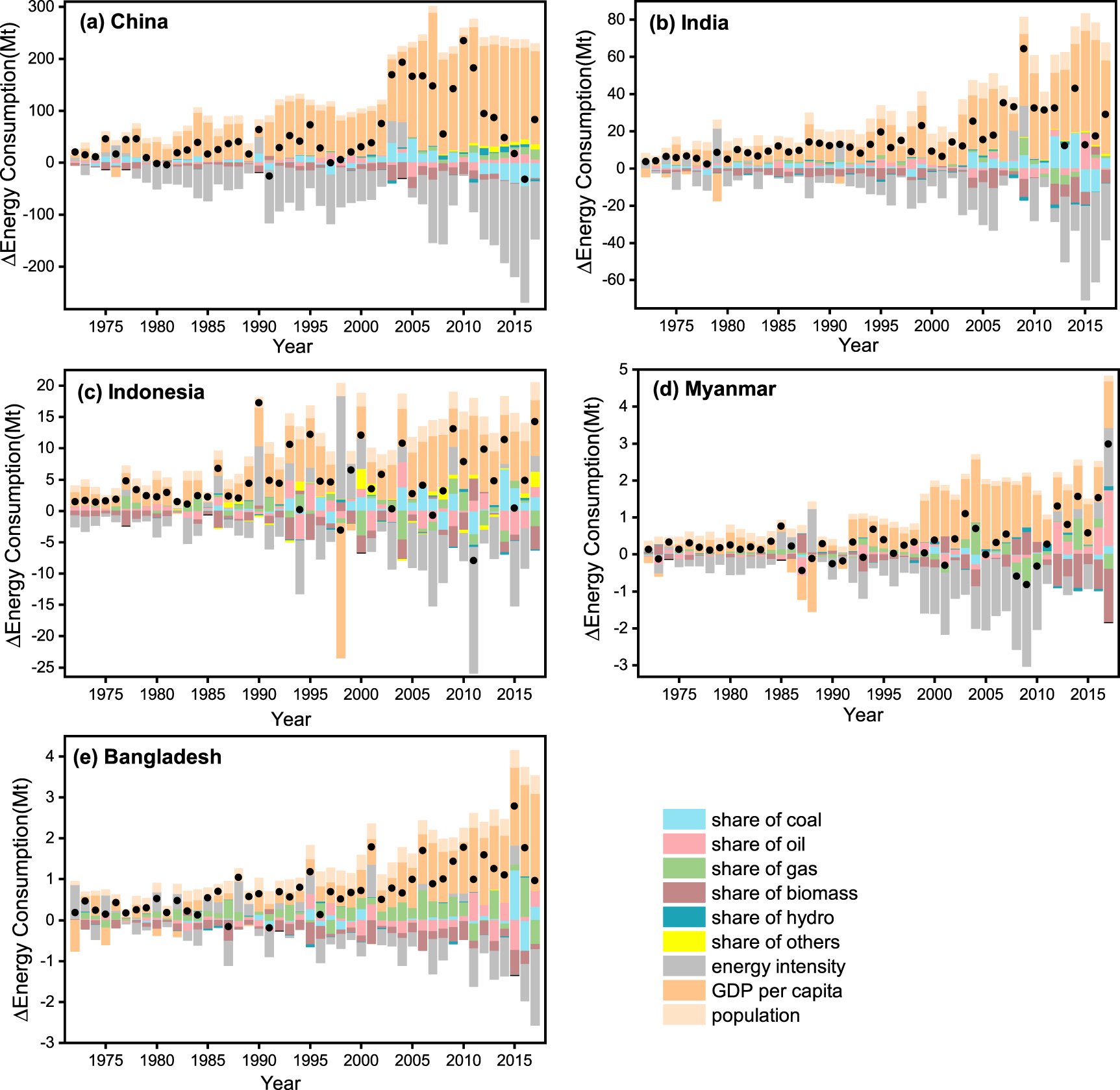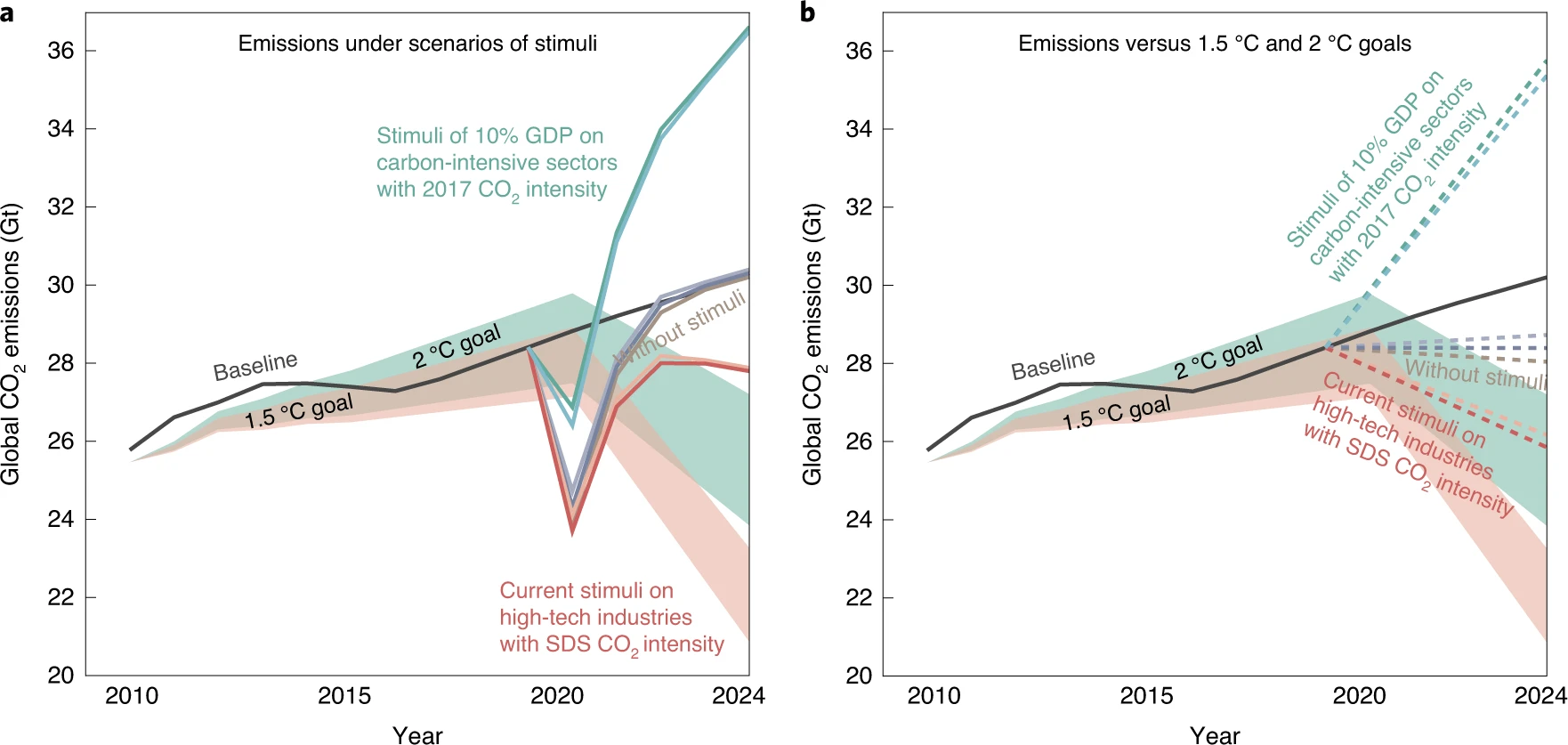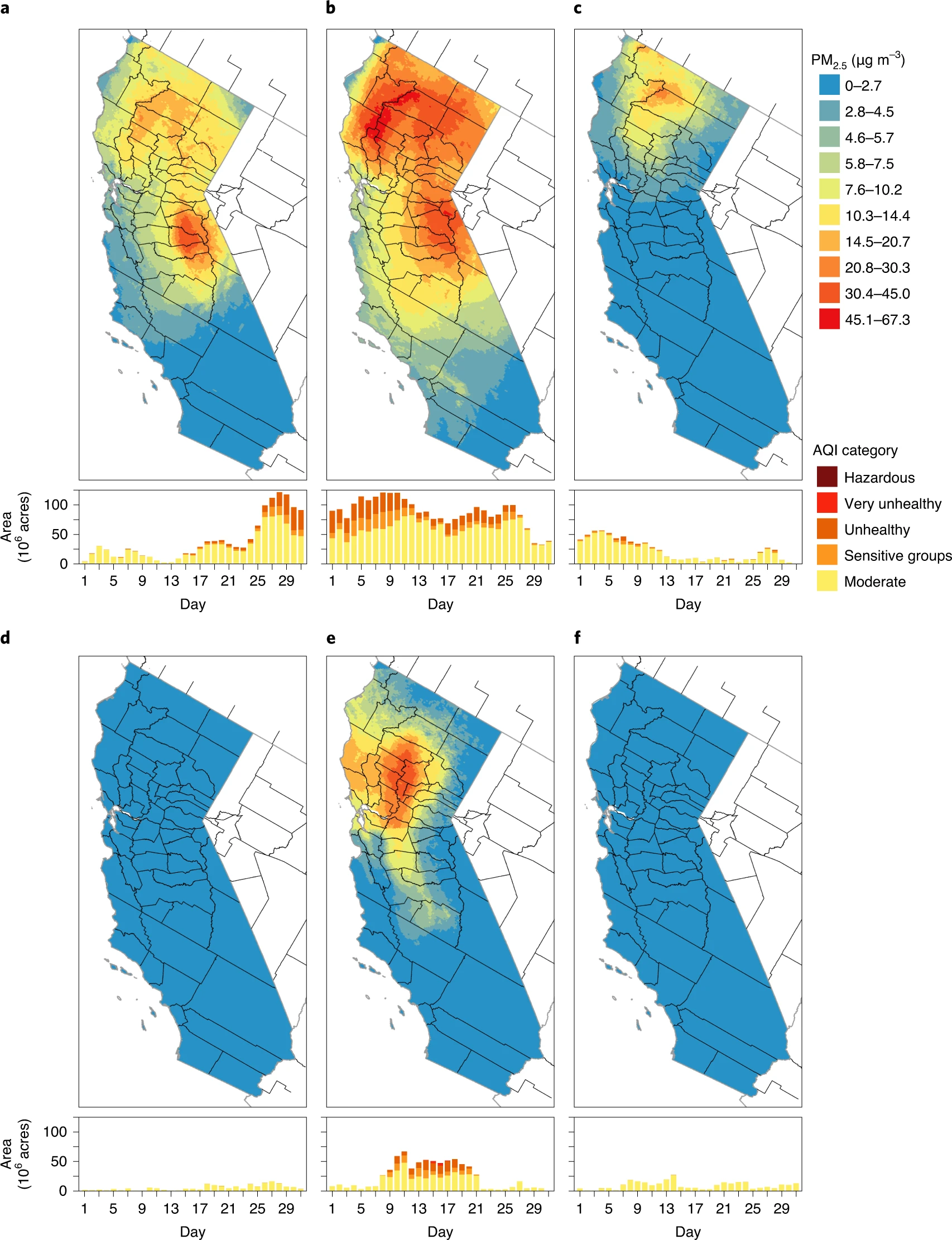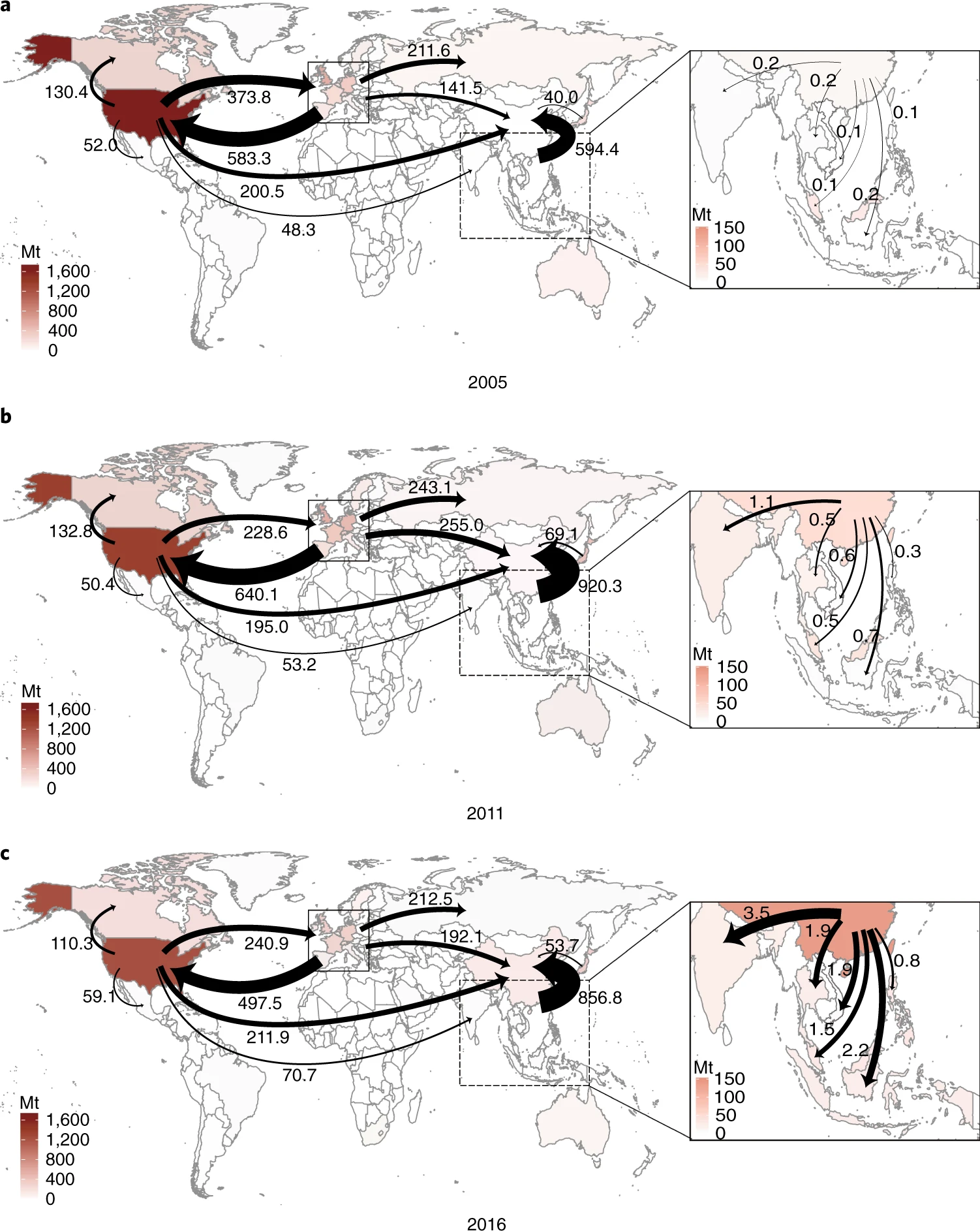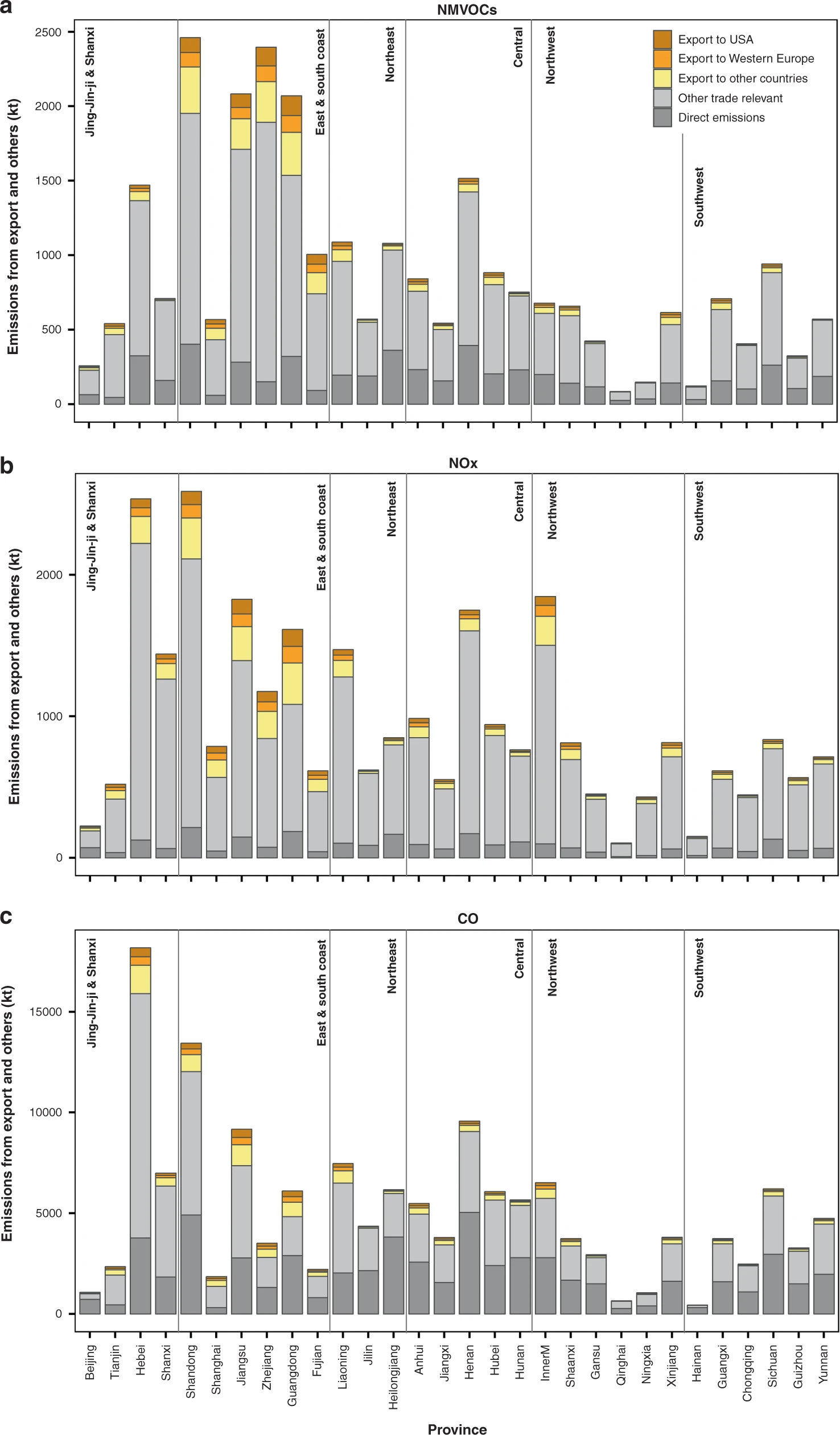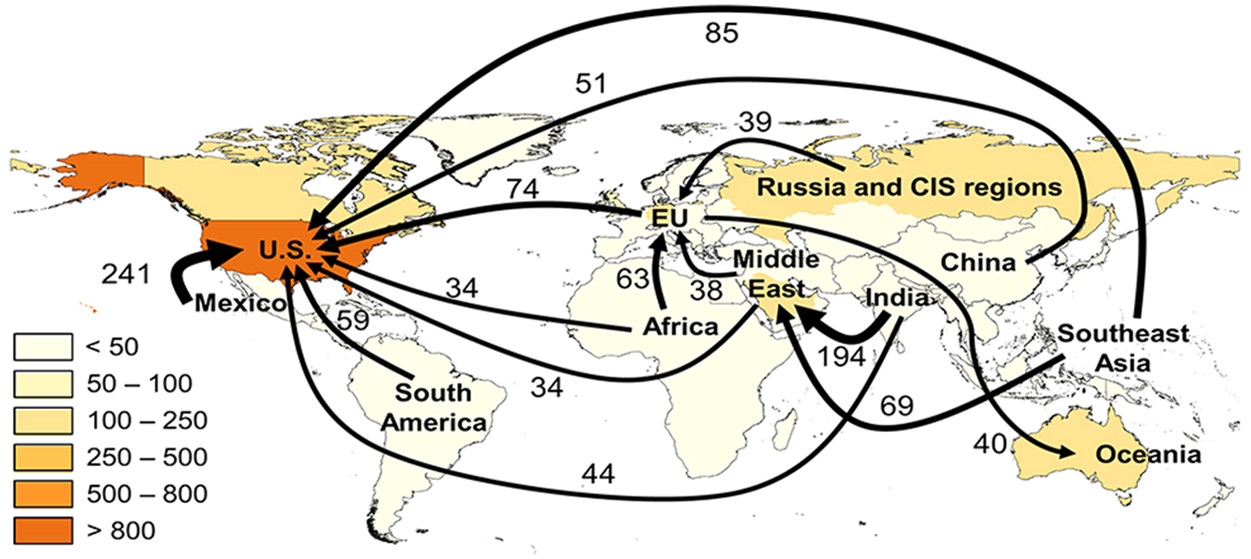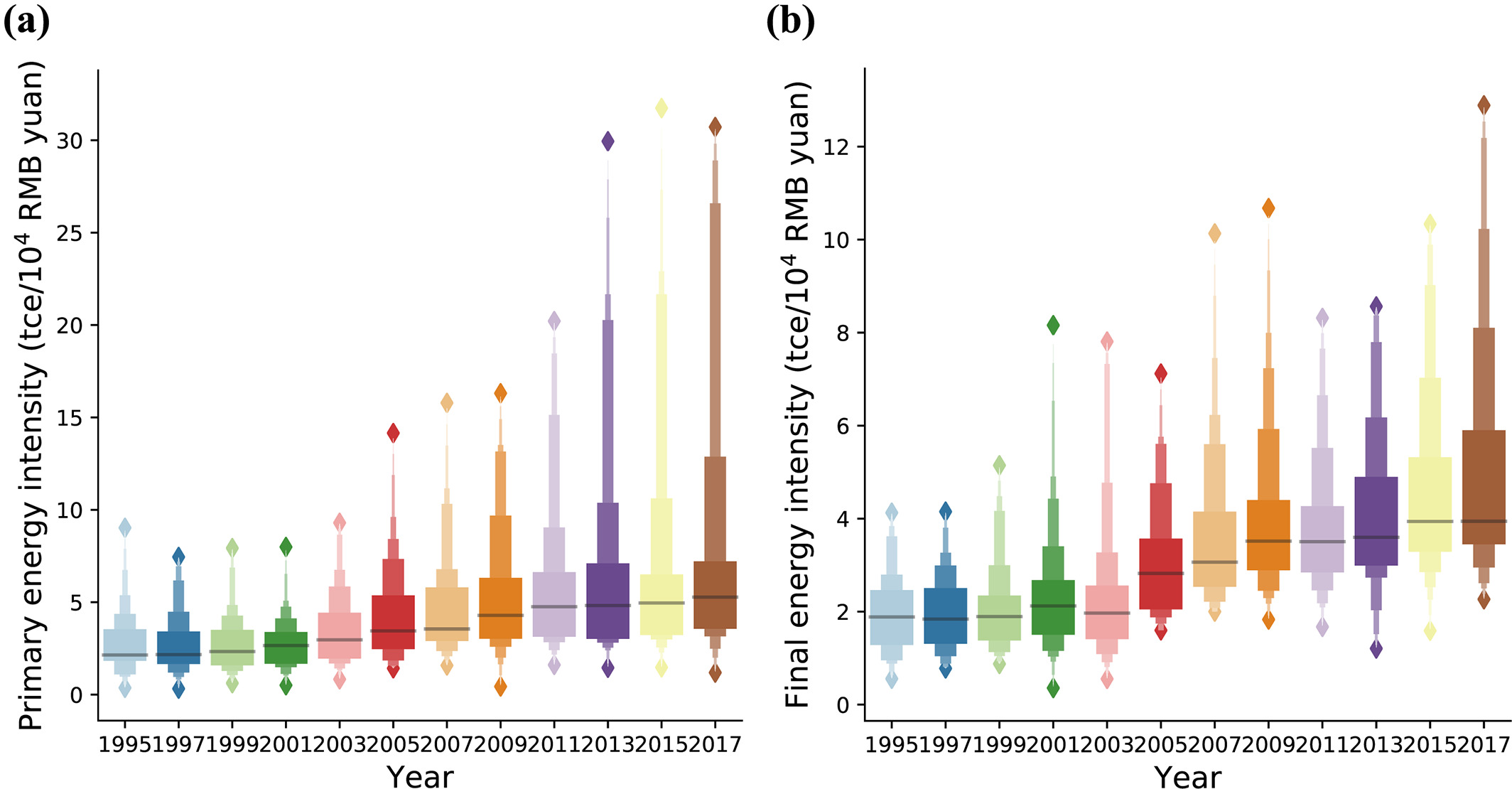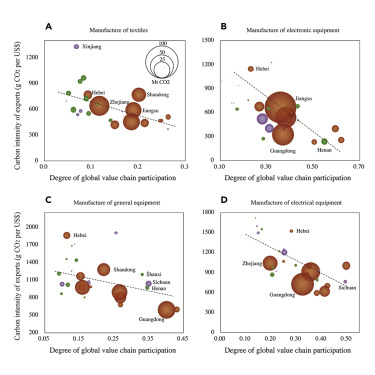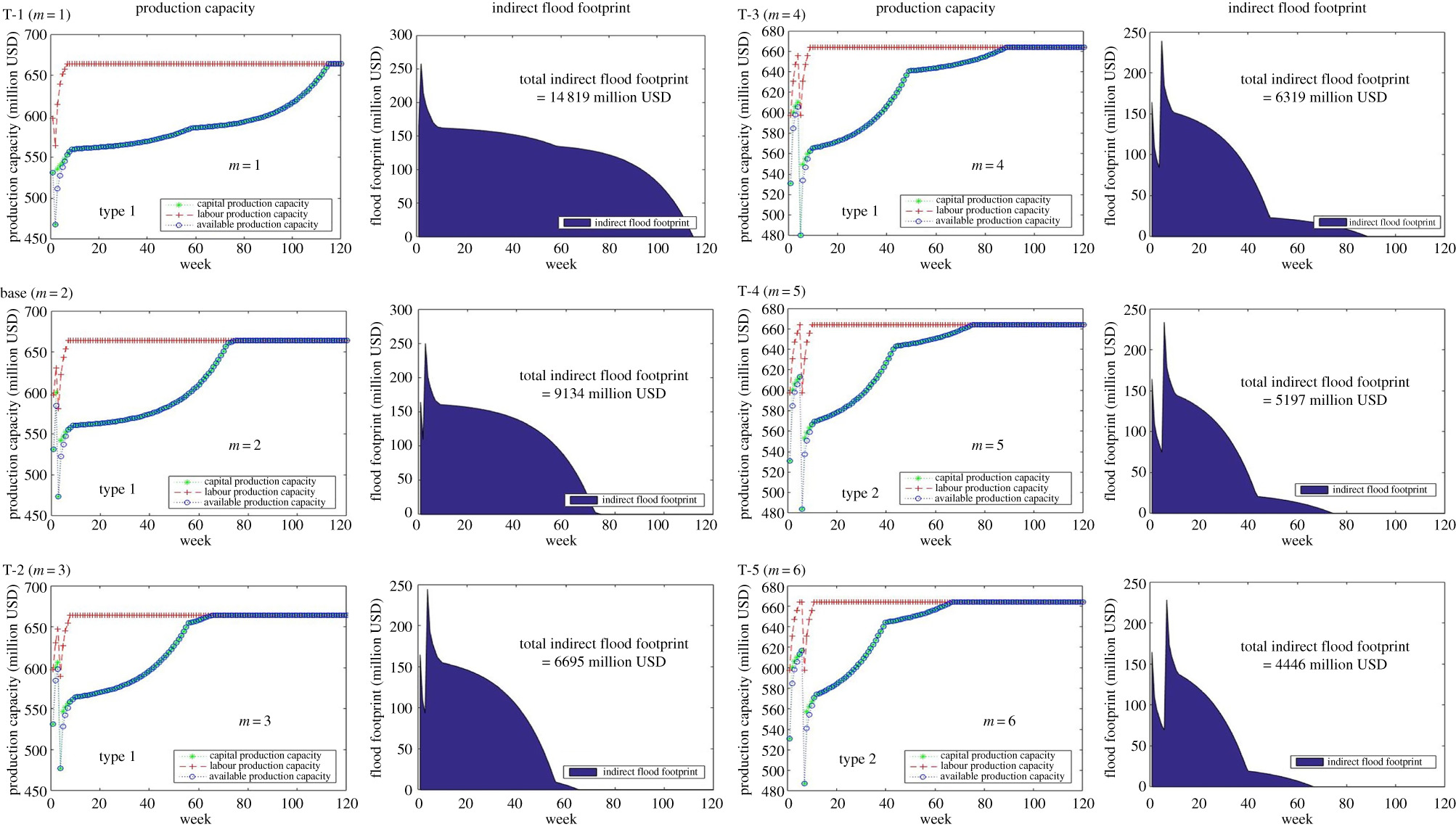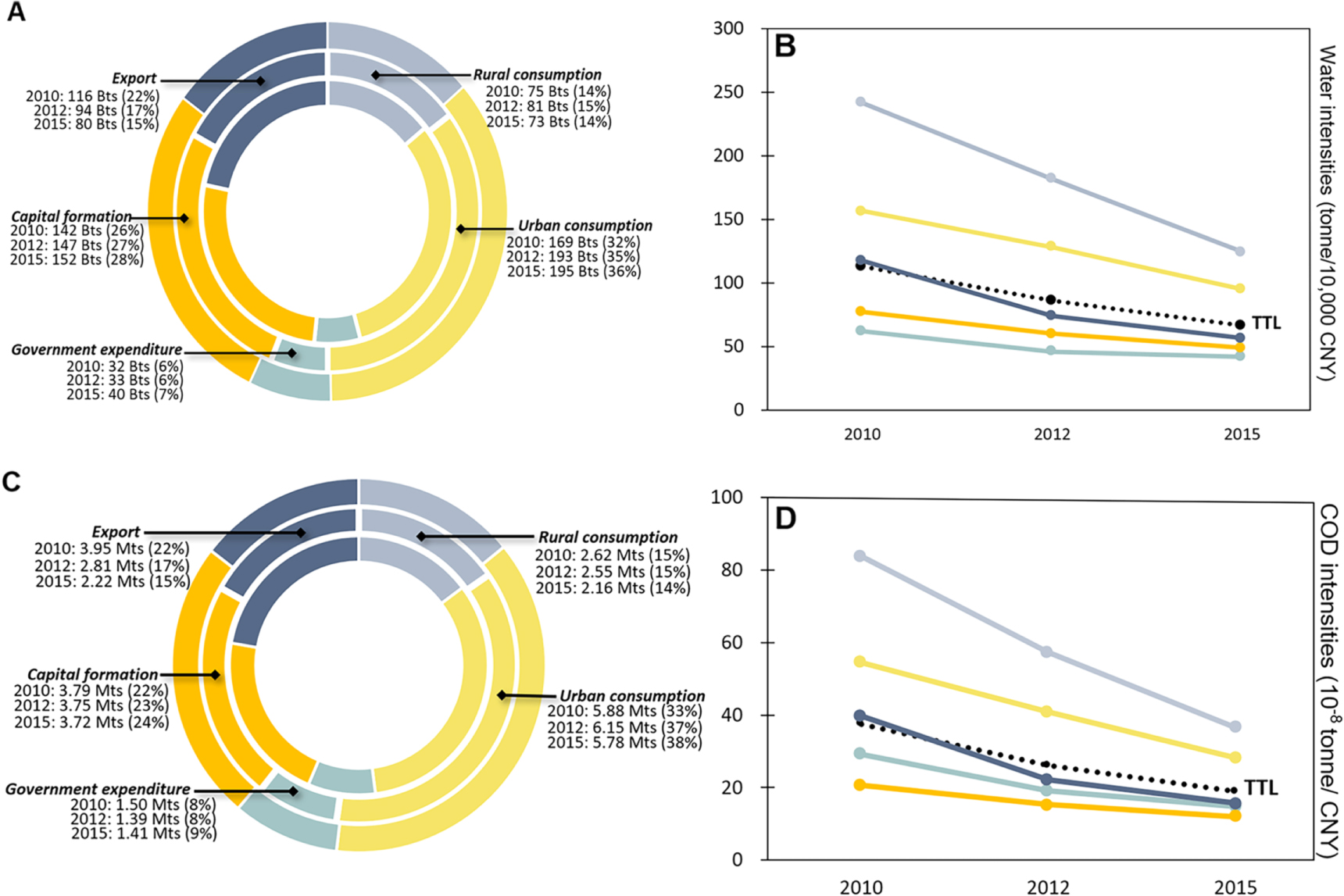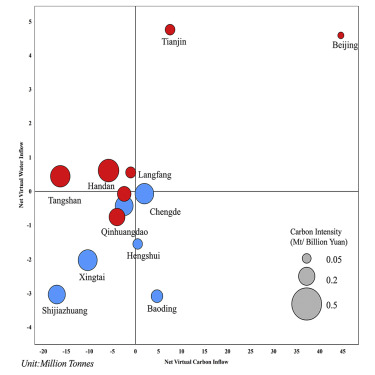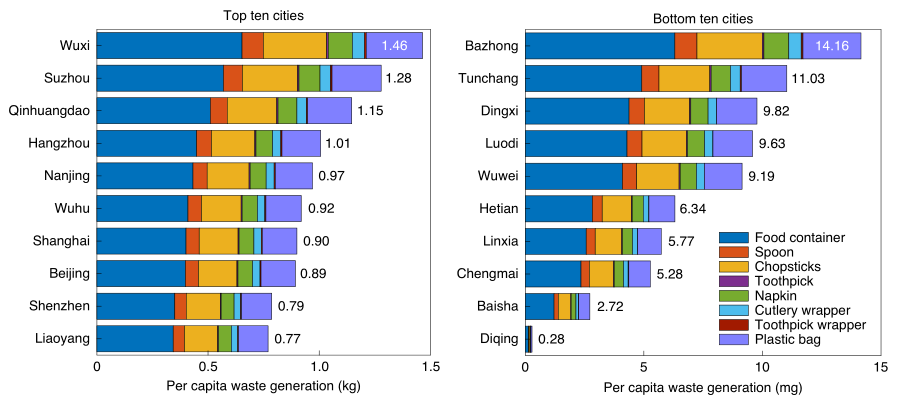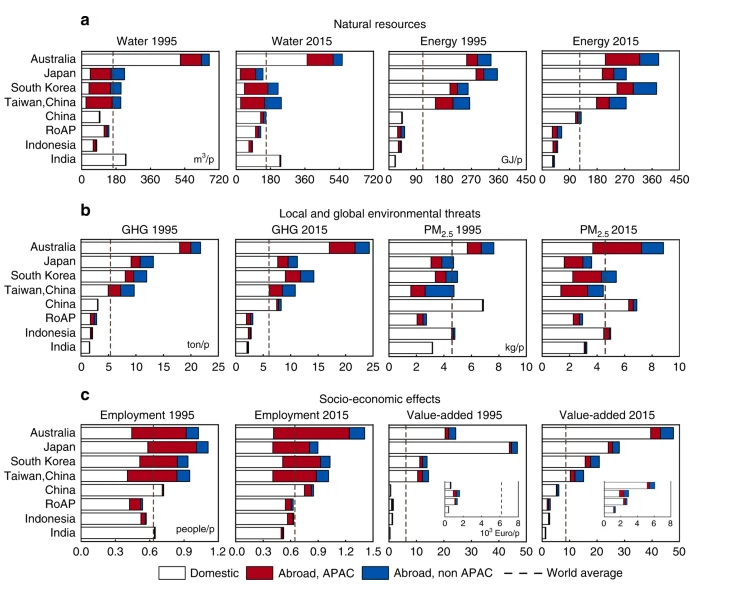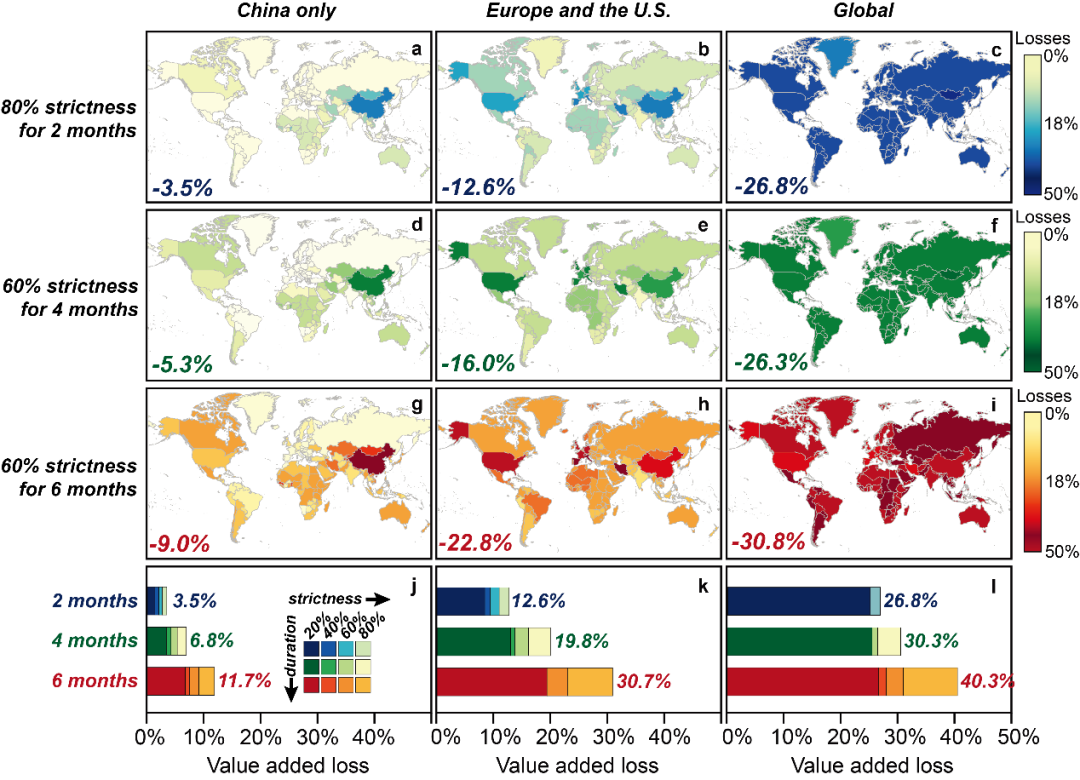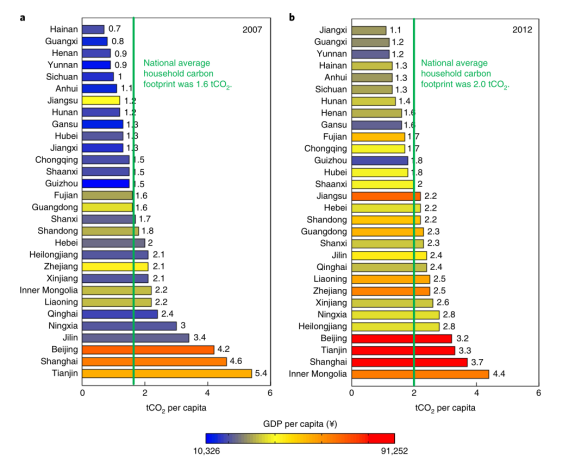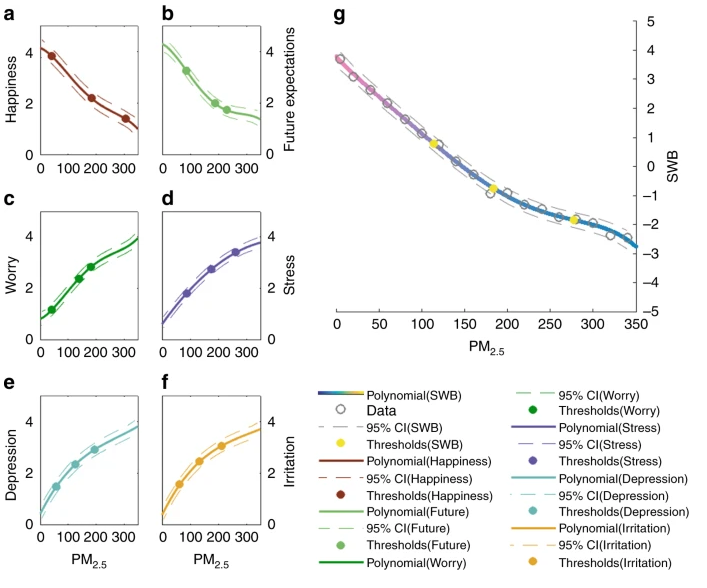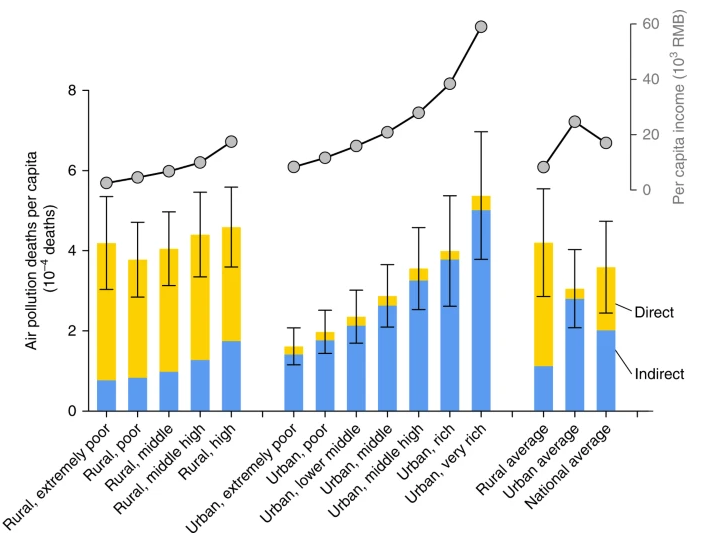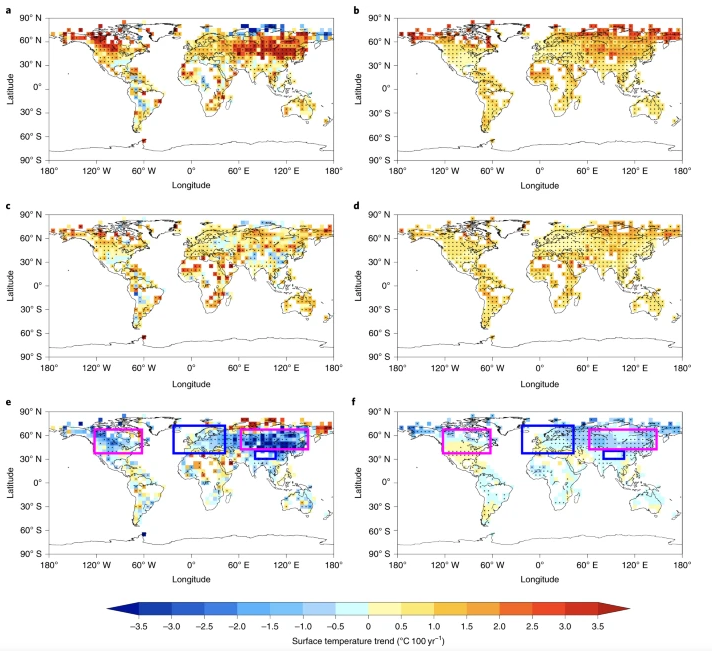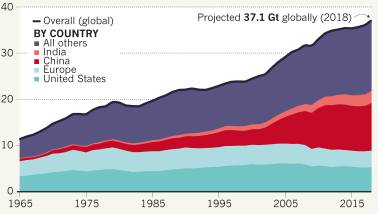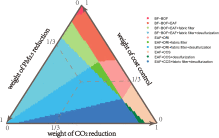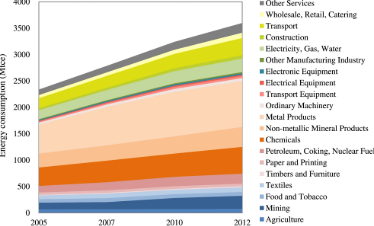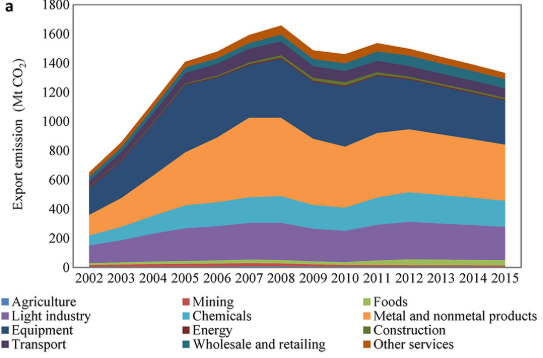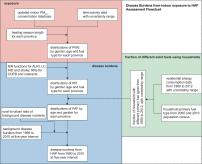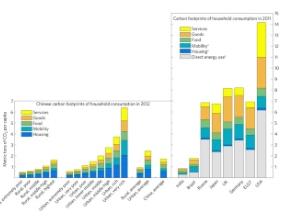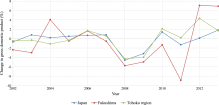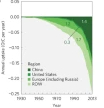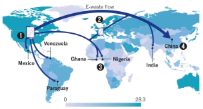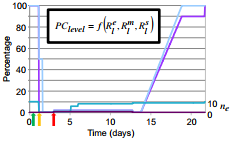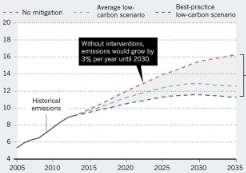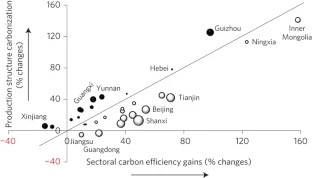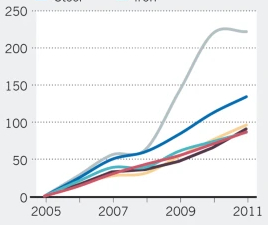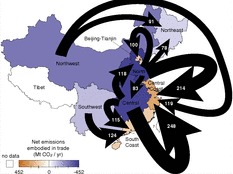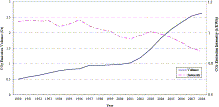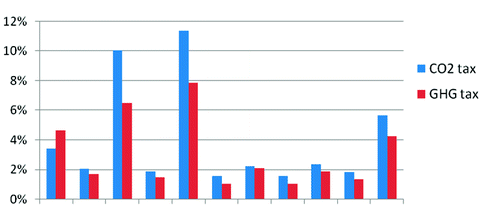政策分析
-
Supply chains create global benefits from improved vaccine accessibility
Ensuring a more equitable distribution of vaccines worldwide is an effective strategy to control global pandemics and support economic recovery. We analyze the socioeconomic effects - defined as health gains, lockdown-easing effect, and supply-chain rebuilding benefit - of a set of idealized COVID-19 vaccine distribution scenarios. We find that an equitable vaccine distribution across the world would increase global economic benefits by ...
-
The climate impact of high seas shipping
Strict carbon emission regulations are set with respect to countries’ territorial seas or shipping activities in exclusive economic zones to meet their climate change commitment under the Paris Agreement. However, no shipping policies on carbon mitigation are proposed for the world’s high seas regions, which results in carbon intensive shipping activities. In this paper, we propose a Geographic-based Emission Estimation Model (GEEM) ...
-
The heterogeneous role of energy policies in the energy transition of Asia–Pacific emerging econom
The achievement of sustainable energy systems requires well-designed energy policies, particularly targeted strategies to plan the direction of energy development, regulations monitored and executed through credible authorities and laws enforced by the judicial system for the enhancement of actions and national targets. The Asia–Pacific region (APAC), responsible for more than half of global energy consumption, has enacted a large numb...
-
Ageing society in developed countries challenges carbon mitigation
Populations in developed countries are ageing. However, the impact of senior citizens’ consumption on global carbon mitigation is poorly understood. Here we find that senior citizens have played a leading role in driving up GHG emissions in the past decade and are on the way to becoming the largest contributor. Considering the greenhouse gas footprint of household consumption across age groups in 32 developed countries, the senior cont...
-
Assessing the economic impacts of future fluvial flooding in six countries under climate change and
Floods are among the most frequent and costliest natural hazards. Fluvial flood losses are expected to increase in the future, driven by population and economic growth in flood-prone areas, and exacerbated in many regions by effects of climate change on the hydrological cycle. Yet, studies assessing direct and indirect economic impacts of fluvial flooding in combination with climate change and socio-economic projections at a country leve...
-
Economic impacts of climate-induced crop yield changes: evidence from agri-food industries in six co
The potential impact of climate change on agriculture has been one of the most discussed topics in the literature on climate change. Although the possible impacts of climate change on crop yields have been widely studied, there remains little quantitative understanding of the heterogeneous economic responses to climate-induced crop yield changes in different economies, particularly at higher levels of warming. This study assesses the eco...
-
Supply chain effects of China's fast growing marine economy on greenhouse gas emissions
The marine economic activities has become a vital economic driving force for development of China's economy. However, the trajectory of greenhouse gas (i.e. GHG) emissions associated the fast growing marine economy and its role in emission mitigation remain unclear. Through compiling high-resolution and time-series environmental input–output tables for 2002, 2007, 2012 and 2017, this study quantify development of 13 key marine industri...
-
Economic growth is principally powered by energy fuels. While the potential energy transition pathwa
Economic growth is principally powered by energy fuels. While the potential energy transition pathways in developed countries are clear, they have not been well explored for developing countries. Here, we study the average annual growth rate of energy consumption in 12 aggregated regions during 2001–2017 and the driving factors behind that growth. The countries with high energy consumption growth rates were concentrated in Asia and Nor...
-
Impacts of COVID-19 and fiscal stimuli on global emissions and the Paris Agreement
The global economy is facing a serious recession due to COVID-19, with implications for CO2 emissions. Here, using a global adaptive multiregional input–output model and scenarios of lockdown and fiscal counter measures, we show that global emissions from economic sectors will decrease by 3.9 to 5.6% in 5 years (2020 to 2024) compared with a no-pandemic baseline scenario (business as usual for economic growth and carbon intensity dec...
-
Economic footprint of California wildfires in 2018
Recent increases in the frequency and scale of wildfires worldwide have raised concerns about the influence of climate change and associated socioeconomic costs. In the western United States, the hazard of wildfire has been increasing for decades. Here, we use a combination of physical, epidemiological and economic models to estimate the economic impacts of California wildfires in 2018, including the value of destroyed and damaged capita...
-
Embodied carbon emissions in the supply chains of multinational enterprises
Enterprises are at the forefront of climate actions and multinational enterprises (MNEs) engage in foreign direct investment, allowing them substantial influence over the entire supply chain. Yet emissions embodied in the international supply chains of MNEs are poorly known. Here we trace the carbon footprints of foreign affiliates of MNEs and show that the gross volume of global carbon transfer through investment peaked in 2011, mainly ...
-
Role of export industries on ozone pollution and its precursors in China
This study seeks to estimate how global supply chain relocates emissions of tropospheric ozone precursors and its impacts in shaping ozone formation. Here we show that goods produced in China for foreign markets lead to an increase of domestic non-methane volatile organic compounds (NMVOCs) emissions by 3.5 million tons in 2013; about 13% of the national total or, equivalent to half of emissions from European Union. Production for export...
-
CO2 Emissions Embodied in International Migration from 1995 to 2015
While present international CO2 mitigation agreements account for the impact of population composition and structure on emissions, the impact of international migration is overlooked. This study quantifies the CO2 footprint of international immigrants and reveals their non-negligible impacts on global CO2 emissions. Results show that the CO2 footprint of international immigrants has increased from 1.8 gigatonnes (Gt) in 1995 to 2.9 Gt in...
-
Enlarging Regional Disparities in Energy Intensity within China
As energy saving and emission reduction become a global action, the disparity in energy intensity between different regions is a new rising problem that stems a country's or region's energy-saving potential. Here we collect China's provincial panel data (1995–2017) of primary and final energy consumption to evaluate China's unequal and polarized regional pattern in energy intensity, decompose the inequality index into contributing com...
-
Production Globalization Makes China’s Exports Cleaner
Production globalization, which is when firms expand their supply chains across national boundaries, creates an opportunity for developing countries to engage in international production networks via trade. Described as the world's factory, China specializes in assembly manufacturing mainly through processing exports. Firms use imported intermediate inputs for production and, after processing or assembly, re-export the finished products ...
-
Methodology and application of flood footprint accounting in a hypothetical multiple two-flood event
Multiple natural disasters are becoming ever more frequent around the world, with both climate change and rapid urbanization increasing the risk of such disasters in human society. Comprehensive analysis of the economic impact of multiple disasters on the industrial and economic system has become an urgent and essential part of urban recovery and sustainable development. However, there is a lack of studies that focus on assessing the in...
-
Quantity and quality of China's water from demand perspectives
China is confronted with an unprecedented water crisis regarding its quantity and quality. In this study, we quantified the dynamics of China's embodied water use and chemical oxygen demand (COD) discharge from 2010 to 2015. The analysis was conducted with the latest available water use data across sectors in primary, secondary and tertiary industries and input–output models. The results showed that (1) China's water crisis was allevi...
-
Mapping Carbon and Water Networks in the North China Urban Agglomeration
Our future is urban. With more than two-thirds of the global population expected to live in cities by 2050, urban sustainability is an essential part of sustainable development but remains poorly understood for urban agglomerations, which continue to develop and grow. Here, we construct a multiregional input-output table at the city level and investigate the impacts of water and carbon flows on the intercity supply chain of the Beijing-T...
-
Energy and air pollution benefits of household fuel policies in northern China
In addition to many recent actions taken to reduce emissions from energy production, industry, and transportation, a new campaign substituting residential solid fuels with electricity or natural gas has been launched in Beijing, Tianjin, and 26 other municipalities in northern China, aiming at solving severe ambient air pollution in the region. Quantitative analysis shows that the campaign can accelerate residential energy transition si...
-
Sharing tableware reduces waste generation, emissions and water consumption in China’s takeaway pa
China has a rapidly growing online food delivery and takeaway market, serving 406 million customers with 10.0 billion orders and generating 323 kilotonnes of tableware and packaging waste in 2018. Here we use a top-down approach with city-level takeaway order data to explore the packaging waste and life-cycle environmental impacts of the takeaway industry in China. The ten most wasteful cities, with just 7% of the population, in terms o...
-
Environmental-social-economic footprints of consumption and trade in the Asia-Pacific region
Asia-Pacific (APAC) has been the world’s most dynamic emerging area of economic development and trade in recent decades. Here, we reveal the significant and imbalanced environmental and socio-economic effects of the region’s growths during 1995-2015. Owing to the intra-regional trade of goods and services, APAC economies grew increasingly interdependent in each other’s water and energy use, greenhouse gas (GHG) and PM2.5 emissions,...
-
Global supply-chain effects of COVID-19 control measures
Countries have sought to stop the spread of coronavirus disease 2019 (COVID-19) by severely restricting travel and in-person commercial activities. Here, we analyse the supply-chain effects of a set of idealized lockdown scenarios, using the latest global trade modelling framework. We find that supply-chain losses that are related to initial COVID-19 lockdowns are largely dependent on the number of countries imposing restrictions and th...
-
Economic development and converging household carbon footprints in China
There are substantial differences in carbon footprints across households. This study applied an environmentally extended multiregional inpu-output approach to estimate household carbon footprints for 12 different income groups of China’s 30 regions. Subsequently, carbon footprint Gini coefficients were calculated to measure carbon inequality for households across provinces. We found that the top 5% of income earners were responsible f...
-
A psychophysical measurement on subjectivewell-being and air pollution
Although the physical effects of air pollution on humans are well documented, there may be even greater impacts on the emotional state and health. Surveys have traditionally been used to explore the impact of air pollution on people’s subjective well-being (SWB). However, the survey techniques usually take long periods to properly match the air pollution characteristics from monitoring stations to each respondent’s SWB at both disag...
-
Inequality of household consumption and air pollution-related deaths in China
Substantial quantities of air pollution and related health impacts are ultimately attributable to household consumption. However, how consumption pattern affects air pollution impacts remains unclear. Here we show, of the 1.08 (0.74-1.42) million premature deaths due to anthropogenic PM2.5 exposure in China in 2012,20% are related to household direct emissions through fuel use and 24% are related to household indirect emissions embodied...
-
Detection of human influences on temperature seasonality from the nineteenth century
It has been widely reported that anthropogenic warming is detectable with high confidence after the 1950s. However, current palaeoclimate records suggest an earlier onset of industrial-era warming. Here, we combine observational data, multiproxy palaeo records and climate model simulations for a formal detection and attribution study. Instead of the traditional approach to the annual mean temperature change, we focus on changes in tempe...
-
Emissions are still rising: ramp up the cuts
With sources of renewable energy spreading fast, all sectors can do more to decarbonize the world, argue Christiana Figueres and colleagues. Representatives of 190 nations gather this week to review progress at the annual United Nations climate talks. They face a daunting reality: carbon dioxide emissions from fossil fuels are rising again. ...
-
Multi-objective analysis of the co-mitigation of CO2 and PM2.5 pollution by China's iron and steel i
China has experienced serious fine particulate matter (PM 2.5 ) pollution in recent years, and carbon dioxide (CO 2 ) emissions must be controlled so that China can keep its pledge to reduce CO 2 emissions by 2030. The iron and steel industry is energy intensive and contributes significantly to PM 2.5 pollution in China. The simultaneous reduction of CO 2 emissions and PM 2.5 pollution while minimizing the total mitigation costs remains...
-
China's Energy Consumption in the New Normal
Energy consumption is one of main reasons for global warming and highly correlated with economic development. As the largest energy consumer worldwide, China has entered a new economic development model—the “new normal.” This study aims to explore the pattern shift in China's energy consumption growth in this new development phase. We use structural decomposition analysis and environmentally extended input‐output analysis to dec...
-
China's “Exported Carbon” Peak: Patterns, Drivers, and Implications
Over the past decade, China has entered a “new normal” phase in economic development, with its role in global trade flows changing significantly. This study estimates the driving forces of Chinese export‐embodied carbon emissions in the new normal phase, based on environmentally extended multiregional input‐output modeling and structural decomposition analysis. We find that Chinese export‐embodied CO 2 emissions peaked in 2008...
-
Cities: the core of climate change mitigation
Cities, the core of the global climate change mitigation and strategic low-carbon development, are shelters to more than half of the world population and responsible for three quarters of global energy consumption and greenhouse gas (GHG). This special volume (SV) provides a platform that promotes multi- and inter- disciplinary analyses and discussions on the climate change mitigation for cities. All papers are divided into four themes,...
-
A review of air pollution impact on subjective well-being: Survey versus visual psychophysics
Air pollution is a worldwide environmental and health issue, especially in major developing countries. A recent World Health Organization report shows about 3 million deaths in the world in 2012 are due to ambient air pollution and China and India are the countries with the most severe challenge. Air pollution influences people's thought and experience of their lives directly by visual perceptions. This reduces people's subjective well-...
-
Estimating household air pollution exposures and health impacts from space heating in rural China
Exposure to and the related burden of diseases caused by pollution from solid fuel cooking, known as household air pollution (HAP), has been incorporated in the assessment of the Global Burden of Diseases (GBD) project. In contrast, HAP from space heating using solid fuels, prevalent in countries at middle or high altitudes , is less studied and missing from the GBD assessment. China is an ideal example to estimate the bias of exposure ...
-
Unequal household carbon footprints in China
Households’ carbon footprints are unequally distributed among the rich and poor due to differences in the scale and patterns of consumption. We present distributional focused carbon footprints for Chinese households and use a carbon-footprint-Gini coefficient to quantify inequalities. We find that in 2012 the urban very rich, comprising 5% of population, induced 19% of the total carbon footprint from household consumption in China, wi...
-
Risk assessment of oil price from static and dynamic modelling approaches
The price gap between West Texas Intermediate (WTI) and Brent crude oil markets has been completely changed in the past several years. The price of WTI was always a little larger than that of Brent for a long time. However, the price of WTI has been surpassed by that of Brent since 2011. The new market circumstances and volatility of oil price require a comprehensive re-estimation of risk. Therefore, this study aims to explore an integr...
-
Flood footprint of the 2007 floods in the UK: The case of the Yorkshire and The Humber region
International headlines over the last few years have been dominated by extreme weather events, and floods have been amongst the most frequent and devastating. These disasters represent high costs and functional disruptions to societies and economies. The consequent breakdown of the economic equilibrium exacerbates the losses of the initial physical damages and generates indirect costs that largely amplify the burden of the total damage....
-
Multiple disasters management: Lessons from the Fukushima triple events
It has been five and a half years since the Great East Japan Earthquake (GEJE) in March 2011. This study summarize management and policy lessons from the GEJE. The recovery efforts that followed the triple disasters: the earthquake, tsunami and meltdown of the Fukushima Dai-ichi nuclear plant are in progress. The experience of the GEJE and tsunami prompted the building of embankments throughout the Pacific coastal side of the Tohoku reg...
-
An index of inequality in China
Household income is a typical measure of inequality, but it is limited by under-reporting, especially for rural Chinese households. A new study shows that energy consumption measures service flows of household durable electronics, which can provide more precise measurement of rural wealth inequalities and distributions. ...
-
Substantial global carbon uptake by cement carbonation
Calcination of carbonate rocks during the manufacture of cement produced 5% of global CO2emissions from all industrial process and fossil-fuel combustion in 2013 1 , 2 . Considerable attention has been paid to quantifying these industrial process emissions from cement production 2 , 3 , but the natural reversal of the process—carbonation—has received little attention in carbon cycle studies. Here, we use new and existing data on cem...
-
Take responsibility for electronic-waste disposal
International cooperation is needed to stop developed nations simply offloading defunct electronics on developing countries, argue Zhaohua Wang, Bin Zhang and Dabo Guan. ...
-
EU-wide economic valuation of adaptation to climate change
Within the BASE project the economic effects of adaptation to climate change are systematically evaluated both from a bottom up and top down perspective. This is done by integrating sectoral models and economic models at EU and global scale with information from selected case studies across sectors and regions within Europe. In addition this layered approach builds upon previous studies that have either focused on a top down modelling or...
-
SESAME: Exploring small businesses’ behaviour to enhance resilience to flooding
In the United Kingdom, small and medium sized enterprises (SMEs) account for approximately 99.9% of businesses, 60% of the working population and 47% annual turnover. However, despite the important contribution that SMEs make to the economy, this size of business remains under-researched with a significant gap in understanding how the disruption caused by flooding impacts on SMEs from the time at which a flood event occurs through to th...
-
Climate policy: Steps to China's carbon peak
Regional targets and improved market mechanisms could enable the nation's carbon dioxide emissions to peak by 2030, say Zhu Liu and colleagues. ...
-
China's toxic informal e-waste recycling: local approaches to a global environmental problem
Electronic waste or e-waste has been an increasingly severe problem over the last decade, and is the fastest growing waste stream in the world. China's inexpensive labour and manufacturing abilities have already made it “the world's factory” and for e-waste recycling it is no exception. Informal workers do the majority of e-waste collection and recycling in cities throughout China. E-waste recycling work provides livelihoods for mig...
-
Determinants of stagnating carbon intensity in China
China committed itself to reduce the carbon intensity of its economy (the amount of CO2emitted per unit of GDP) by 40–45% during 2005–2020. Yet, between 2002 and 2009, China experienced a 3% increase in carbon intensity, though trends differed greatly among its 30 provinces. Decomposition analysis shows that sectoral efficiency gains in nearly all provinces were offset by movement towards a more carbon-intensive economic structure. ...
-
Energy Policy: A low-carbon roadmap for China
Recycling, renewables and a reinvigorated domestic energy market will allow China to lead the world in low-carbon development, say Zhu Liu and colleagues....
-
Outsourcing CO2 within China
Recent studies have shown that the high standard of living enjoyed by people in the richest countries often comes at the expense of CO2emissions produced with technologies of low efficiency in less affluent, developing countries. Less apparent is that this relationship between developed and developing can exist within a single country’s borders, with rich regions consuming and exporting high-value goods and services that depend upon p...
-
China’s water management – challenges and solutions
China has experienced enormously rapid development since the open door policy introduced in 1979. Population has increased by 30% to 1.3 billion, and the annual GDP growth rate is at 9.8 %. Nevertheless, frequent water disasters of recent years have caused significant damage to China’s regional growth and societies. There are huge contemporary challenges for Chinese water resources management. In this paper, we examine three major cha...
-
Preliminary exploration on low-carbon technology roadmap of China’s power sector
Climate change poses huge challenges to the sustainable development of human society. As a major CO2emission source, decarbonization of power sector is fundamental for CO2emission abatement. Therefore, considering the “carbon lock-in” effects, it’s critical to formulate an appropriate roadmap for low-carbon generation technologies. In this paper, key low-carbon technology solutions are firstly identified according to their develop...
-
Distributional Effects of Climate Change Taxation: The Case of the UK
Current economic instruments aimed at climate change mitigation focus mainly on CO2emissions, but efficient climate mitigation needs to focus on other greenhouse gases as well as CO2. This study investigates the distributional effects of climate change taxes on households belonging to different income and lifestyle groups; and it compares the effects of a CO2tax with a multiple GHG tax in the UK in terms of cost efficiency and distribut...

